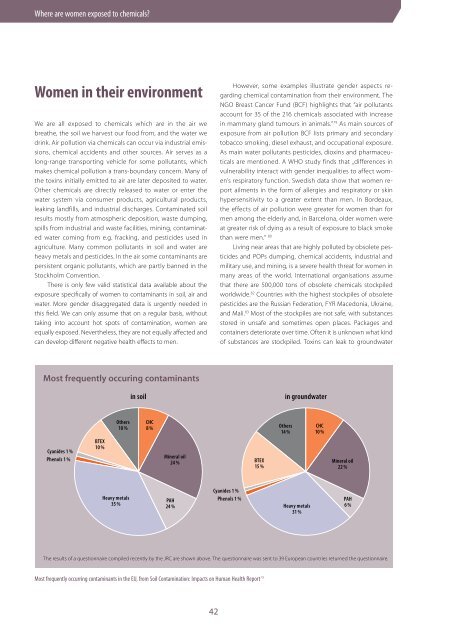Women and Chemicals
1ToENNR
1ToENNR
Create successful ePaper yourself
Turn your PDF publications into a flip-book with our unique Google optimized e-Paper software.
Where are women exposed to chemicals?<br />
<strong>Women</strong> in their environment<br />
We are all exposed to chemicals which are in the air we<br />
breathe, the soil we harvest our food from, <strong>and</strong> the water we<br />
drink. Air pollution via chemicals can occur via industrial emissions,<br />
chemical accidents <strong>and</strong> other sources. Air serves as a<br />
long-range transporting vehicle for some pollutants, which<br />
makes chemical pollution a trans-boundary concern. Many of<br />
the toxins initially emitted to air are later deposited to water.<br />
Other chemicals are directly released to water or enter the<br />
water system via consumer products, agricultural products,<br />
leaking l<strong>and</strong>fills, <strong>and</strong> industrial discharges. Contaminated soil<br />
results mostly from atmospheric deposition, waste dumping,<br />
spills from industrial <strong>and</strong> waste facilities, mining, contaminated<br />
water coming from e.g. fracking, <strong>and</strong> pesticides used in<br />
agriculture. Many common pollutants in soil <strong>and</strong> water are<br />
heavy metals <strong>and</strong> pesticides. In the air some contaminants are<br />
persistent organic pollutants, which are partly banned in the<br />
Stockholm Convention.<br />
There is only few valid statistical data available about the<br />
exposure specifically of women to contaminants in soil, air <strong>and</strong><br />
water. More gender disaggregated data is urgently needed in<br />
this field. We can only assume that on a regular basis, without<br />
taking into account hot spots of contamination, women are<br />
equally exposed. Nevertheless, they are not equally affected <strong>and</strong><br />
can develop different negative health effects to men.<br />
However, some examples illustrate gender aspects regarding<br />
chemical contamination from their environment. The<br />
NGO Breast Cancer Fund (BCF) highlights that “air pollutants<br />
account for 35 of the 216 chemicals associated with increase<br />
in mammary gl<strong>and</strong> tumours in animals.” 79 As main sources of<br />
exposure from air pollution BCF lists primary <strong>and</strong> secondary<br />
tobacco smoking, diesel exhaust, <strong>and</strong> occupational exposure.<br />
As main water pollutants pesticides, dioxins <strong>and</strong> pharmaceuticals<br />
are mentioned. A WHO study finds that „differences in<br />
vulnerability interact with gender inequalities to affect women’s<br />
respiratory function. Swedish data show that women report<br />
ailments in the form of allergies <strong>and</strong> respiratory or skin<br />
hypersensitivity to a greater extent than men. In Bordeaux,<br />
the effects of air pollution were greater for women than for<br />
men among the elderly <strong>and</strong>, in Barcelona, older women were<br />
at greater risk of dying as a result of exposure to black smoke<br />
than were men.“ 80<br />
Living near areas that are highly polluted by obsolete pesticides<br />
<strong>and</strong> POPs dumping, chemical accidents, industrial <strong>and</strong><br />
military use, <strong>and</strong> mining, is a severe health threat for women in<br />
many areas of the world. International organisations assume<br />
that there are 500,000 tons of obsolete chemicals stockpiled<br />
worldwide. 82 Countries with the highest stockpiles of obsolete<br />
pesticides are the Russian Federation, FYR Macedonia, Ukraine,<br />
<strong>and</strong> Mali. 83 Most of the stockpiles are not safe, with substances<br />
stored in unsafe <strong>and</strong> sometimes open places. Packages <strong>and</strong><br />
containers deteriorate over time. Often it is unknown what kind<br />
of substances are stockpiled. Toxins can leak to groundwater<br />
Most frequently occuring contaminants<br />
in soil<br />
in groundwater<br />
Cyanides 1 %<br />
Phenols 1 %<br />
BTEX<br />
10 %<br />
Others<br />
10 %<br />
CHC<br />
8 %<br />
Mineral oil<br />
24 %<br />
BTEX<br />
15 %<br />
Others<br />
14 %<br />
CHC<br />
10 %<br />
Mineral oil<br />
22 %<br />
Heavy metals<br />
35 %<br />
PAH<br />
24 %<br />
Cyanides 1 %<br />
Phenols 1 %<br />
Heavy metals<br />
31 %<br />
PAH<br />
6 %<br />
The results of a questionnaire compiled recently by the JRC are shown above. The questionnaire was sent to 39 European countries returned the questionnaire.<br />
Most frequently occurring contaminants in the EU, from Soil Contamination: Impacts on Human Health Report 78<br />
42


